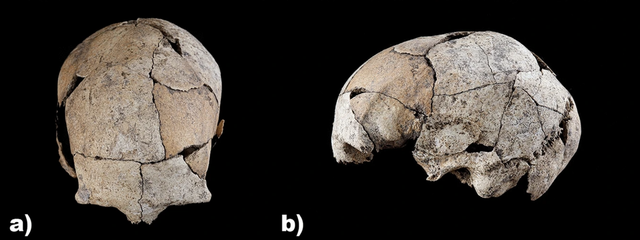Ancient skull shows evidence of the first human ear surgery
Archaeologists suspect the patient may have had an acute bilateral middle ear infection, causing ear pain and fever. If left untreated, fluid can collect behind the eardrum, cause a tumor in the skull, cause hearing loss, or even a life-threatening pericarditis.
Ear surgery is a common practice today, but in the mid-19th century, ear surgery was performed only in desperate attempts to save lives. Although some ancient writings have suggested some surgical interventions from the first century, there is still no solid evidence.
The discovery from this ancient skull suggests that similar processes may even have been performed thousands of years earlier.

Front and side view of skull. (Photo: Science Alert)
The skull in this case was found at a burial site known as the Dolmen of El Pendónis, which was used as a burial ground in the fourth millennium BC. Burial administrators seem to have deliberately separated the heads, limbs and pelvises of dozens of corpses in a ritualistic manner.
This skull belonged to a woman, but because it had no teeth or other limbs, it was difficult for archaeologists to determine the woman’s age.
Based on the lack of teeth in the skeleton and the fusion of the skull bones, the researchers suggest that the woman may have been between 35 and 50 years old, an age that was considered long-lived at that time.
There is also evidence that the woman had undergone some sort of ear surgery. This ear infection appears to be quite severe, as without anesthesia, the researchers predict that prehistoric ear surgery would be unbearably painful.
To drill through the skull behind the ear, a woman needs to be held and pinned down, or given a substance that can cause the patient to lose part of her consciousness.

Bone scan around right ear (a) and left ear (b). (Photo: Science Alert)
However, the surgery appears to have been a success. The bones near both ears of the skull showed signs of deterioration, confirming infection at some point, but they also showed no signs of infection at the time of death. In fact, there is obvious regeneration and healing, which is a common part of the healing process.
While both ears were likely to require surgery, only the left ear of the skull had V-shaped cutter marks. The fact that these marks were lost on the right ear side indicates these injuries. healed when the woman died.
Based on the difference in bone remodeling between the temples, it is likely that this surgery was performed first on the right ear, due to an alarmingly sufficient ear pathology that warrants intervention, which this prehistoric woman survived.
Then the left ear was intervened. However, it is not possible to determine whether both interventions were carried out consecutively or several months or even years apart. Accordingly, this is the earliest recorded evidence of an operation on both temporal bones. And so this is most likely the first known radical mastectomy in human history.”
at Blogtuan.info – Source: danviet.vn – Read the original article here
